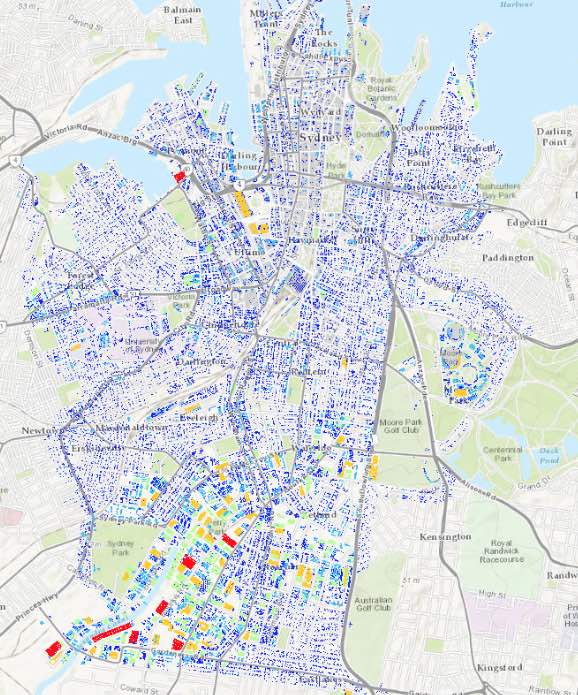Australia might be a world leader in rooftop solar penetration, but according to a new Sydney-focused study, we are only just scratching the surface of our true small-scale solar potential, particularly in the nation’s major cities.
The Australia Photovoltaic (PV) Institute study, published by a University of New South Wales team on Tuesday, finds that Sydney’s CBD has solar on just 1 per cent of its suitable rooftops – a total of around 6.7MW of installed capacity – when between 25-40 per cent of the city’s buildings could host PV panels.
The researchers came to this conclusion by comparing data on roof size, aspect and tilt, as well as shading patterns and insolation levels across the City of Sydney – data largely gathered using the APVI Solar Potential Tool, developed by researchers at UNSW.
According to APVI chair, Dr Renate Egan, using the Solar Potential Map is “as accurate as going on the roof and taking measurements for a whole year,” and demonstrates the “massive savings” – both on power costs and on emissions – that are there to be had.
By the study’s most conservative estimations, Sydney’s CBD holds around 393MW of untapped PV potential – or 507GWh a year – with around 25 per cent of its rooftops both suited for and able to accommodate solar panels.
A less conservative estimate, however, indicated that an area equal to 40 per cent of the available roof surfaces could be used to accommodate PV, corresponding to 619MW of potential PV capacity with an expected annual yield of 777GWh – or around 22 per cent of the load in the CBD.
As for the cost, the report estimates that if the 25 per cent solar roof potential of 393MW was installed, the collective cost would total around $475 million, and generate savings of around $70 million a year – more if electricity prices continue to rise.
“NSW residents have embraced the solar revolution on their own homes but, as this report identifies, there’s a solar goldmine right under our noses that hasn’t been tapped,” said the state’s renewable energy advocate, Amy Kean, on Tuesday.
“With energy prices set to rise mid-year, there is a real opportunity to harness the solar potential of the Sydney CBD to reduce demand from the grid and help businesses and families with their electricity bills,” she said.
Of course, Australia’s cities aren’t the only untapped goldmines, and UNSW researchers are not the only prospectors.
Jelmer van Rooij – a Dutch student of energy technology who came to Australia in 2016 to “explore the (local) clean energy transition” – immediately recognised huge untapped rooftop solar value.
Since then, as we reported here in August last year, Van Rooij has been working on developing his own solar mapping tool, called Solar Captus, that will use satellite imaging and image recognition software to create “the world’s first” database for rooftop solar.
The Solar Captus, which has its origins in the CSIRO’s Solar Hackathon event of April 2016, while not yet commercially available, was being trialled in the Netherlands in April this year.
But van Rooij believes it could be a goldmine of information as Australia transitions to distributed renewable energy.
“A lot of people with solar aren’t completely aware of the value that solar can have,” he said in an interview with One Step Off The Grid last August. “To convince these people to use their solar in the right way, you need to find the right households to target.
“Energy companies might have this data, but aren’t necessarily motivated to use it,” he said.
“There are a lot of companies that can actually enter this industry, like Google or Telstra, …who are thinking, these customers already have an above average interest in energy, what can I provide them with to enhance their existing energy system?”
And this is where van Rooij hopes his solar mapping tool will come in.
“(The data) empowers the right companies and a great diversity of companies to provide a range of services to give customers the services to get the most value from their renewable energy systems and to lead the transition to distributed energy,” he said.
“The energy industry has been dominated by small number of companies. They’re like inefficient machines. Now, with software, distributed energy changes the whole game. There are so many opportunities for a range of companies,” he said.
The UNSW APVI study provides a few tangible examples of this un-tapped opportunity, by modelling how some of Sydney’s landmark buildings could be transformed by solar, including its Central Station, the Overseas Passenger Terminal and the Art Gallery of NSW.
In the case of the Central Station, pictured below with its potential PV array, the study found that 3MW of solar , covering just over half of its roof, could generate 3599MWh/year, enough to power 535 homes.
 This article was originally published on RenewEconomy’s sister site, One Step Off The Grid, which focuses on customer experience with distributed generation. To sign up to One Step’s free weekly newsletter, please click here.
This article was originally published on RenewEconomy’s sister site, One Step Off The Grid, which focuses on customer experience with distributed generation. To sign up to One Step’s free weekly newsletter, please click here.









